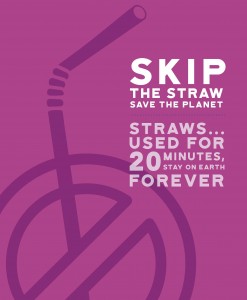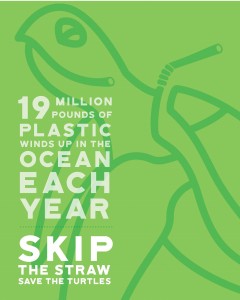Fort Lauderdale/ Davie Campus First; Other NSU Locations to Follow Suit
FOR IMMEDIATE RELEASE
FORT LAUDERDALE/DAVIE, Fla. – Joining an ever-growing list of corporations, organizations and municipalities that are taking steps to reduce their dependency on single-use plastics, Nova Southeastern University (NSU) will be eliminating the use of plastic straws, first at it’s Fort Lauderdale/Davie campus, then the other NSU locations.
 “This was something we heard about from students, faculty and staff,” said Dr. George Hanbury, President of NSU. “The time has come for NSU to take a first-step in addressing single-use plastics on our campuses. It may be a small step, but every bit helps address the bigger issue.”
“This was something we heard about from students, faculty and staff,” said Dr. George Hanbury, President of NSU. “The time has come for NSU to take a first-step in addressing single-use plastics on our campuses. It may be a small step, but every bit helps address the bigger issue.”
Dr. Hanbury hopes that by NSU taking this step, it may inspire public and private sector organizations to explore the possibility of doing so as well.
While NSU will be replacing plastic straws with more environmentally-friendly paper versions, the university will still have plastic straws on hand for individuals with disabilities or special needs who need to use them, and they’ll be made available upon request. The fact is in most cases, straws are not needed – they aren’t the product people are purchasing, they are an accessory. You can still buy a soda or cup of iced coffee and simply drink from the cup – the straw is superfluous.
The campus is home to third-party vendors (i.e. Starbucks) who are also exploring the possibility of following NSU’s lead and switching to paper straws.
For many years the outcry about plastics polluting our oceans has been heard near and far. Almost weekly there are news reports of marine creatures washing up on beaches that have their digestive systems clogged with plastic trash. Plastics have been found in all of the world’s oceans, in the polar ice caps and even at the deepest part of the ocean, the Marianas Trench.
 “Many people have said that, in the grand scheme of things, reducing straw usage is just a drop in the bucket when it comes to addressing plastic trash,” said Dr. Derek Burkholder, a marine research scientist in NSU’s Halmos College of Natural Sciences and Oceanography. “While that may be true, the fact remains that plastic straws are part of the problem, so we can start there and then see what else we can do to reduce our plastic footprint.”
“Many people have said that, in the grand scheme of things, reducing straw usage is just a drop in the bucket when it comes to addressing plastic trash,” said Dr. Derek Burkholder, a marine research scientist in NSU’s Halmos College of Natural Sciences and Oceanography. “While that may be true, the fact remains that plastic straws are part of the problem, so we can start there and then see what else we can do to reduce our plastic footprint.”
Burkholder, who is also the director of the Broward County Sea Turtle Conservation Program and the Marine Environmental Education Center at the Carpenter House, said there are some reports that show that just in the United States and United Kingdom, nearly 550 million plastic straws are thrown away every day. In fact, approximately 50% of all plastic is single use, with an average “useful lifetime” of 12 minutes.
There are simple steps that people can take to help reduce their plastic footprint. From not using plastic straws to using reusable bags when grocery shopping, each action, no matter how small, helps remove plastic trash from landfills or the ocean.
Working with sea turtles, Burkholder and his colleagues have had to deal with the unfortunate reality of dead animals washing up on our beaches. And when they perform a necropsy he said that, inevitably, they find various bits of plastic in the turtle’s stomach.
Burkholder said it’s not just sea turtles – plastics are finding their ways into all sorts of marine creatures, great and small, from plankton to sperm whales. Even shore birds are being found with significant amounts of plastics in their digestive systems. Plastic isn’t biodegradable, it simply breaks down into smaller and smaller particles, including micro plastics, that are ingested.
“If you think about it, we’re polluting ourselves,” he said. “The fish eat the plastics, which metabolizes into their fat reserves and then we catch and eat the fish. We’re throwing plastics into the oceans and then, sooner or later, we wind up ingesting those same plastics.”
Be sure to sign up for NSU’s RSS feed so you don’t miss any of our news releases, guest editorials and other announcements. Please sign up HERE.
###
About Nova Southeastern University (NSU): Located in beautiful Fort Lauderdale, Florida, NSU is ranked among U.S. News & World Report’s Top 200 National Research Universities and is a dynamic, private research university providing high-quality educational and research programs at the undergraduate, graduate, and first-professional degree levels. Established in 1964, NSU now includes 16 colleges, the 215,000-square-foot Center for Collaborative Research, a private JK-12 grade school, the Mailman Segal Center for Human Development with specialists in Autism, the world-class NSU Art Museum Fort Lauderdale, and the Alvin Sherman Library, Research and Information Technology Center, which is Florida’s largest public library. NSU has campuses in Fort Lauderdale, Fort Myers, Jacksonville, Miami, Miramar, Orlando, Palm Beach, and Tampa, Florida, as well as San Juan, Puerto Rico, while maintaining a presence online globally. Classified as a research university with “high research activity” by the Carnegie Foundation for the Advancement of Teaching, NSU is one of only 50 universities nationwide to also be awarded Carnegie’s Community Engagement Classification, and is also the largest private institution in the United States that meets the U.S. Department of Education’s criteria as a Hispanic-serving Institution. For more information, please visit www.nova.edu.
About NSU’s Halmos College of Natural Sciences and Oceanography: The college provides high-quality undergraduate (bachelor’s degree) and graduate (master’s and doctoral degrees and certificates) education programs in a broad range of disciplines, including marine sciences, mathematics, biophysics, and chemistry. Researchers carry out innovative basic and applied research programs in coral reef biology, ecology, and geology; fish biology, ecology, and conservation; shark and billfish ecology; fisheries science; deep-sea organismal biology and ecology; invertebrate and vertebrate genomics, genetics, molecular ecology, and evolution; microbiology; biodiversity; observation and modeling of large-scale ocean circulation, coastal dynamics, and ocean atmosphere coupling; benthic habitat mapping; biodiversity; histology; and calcification. The college’s newest building is the state-of-the-art Guy Harvey Oceanographic Center, an 86,000-square-foot structure filled with laboratories; offices; seminar rooms; an auditorium; and indoor and outdoor running sea water facilities. Please visit cnso.nova.edu for more information.
November 12, 2018
MEDIA CONTACT
Joe Donzelli | Office of Media Relations
Nova Southeastern University
954-262-2159 (office) | 954-661-4571 (cell)
jdonzelli@nova.edu | www.nova.edu | @NSU_Joe